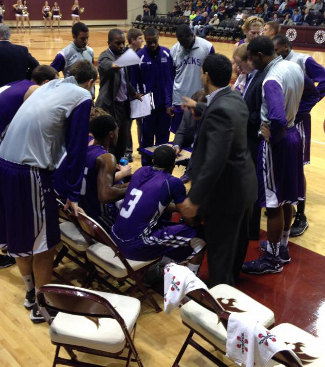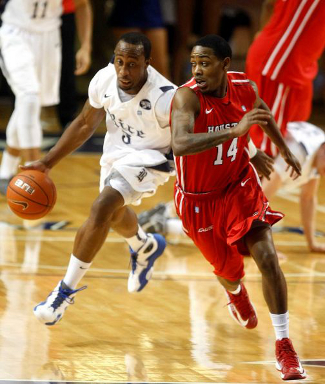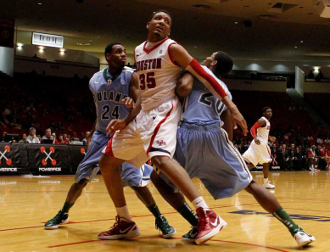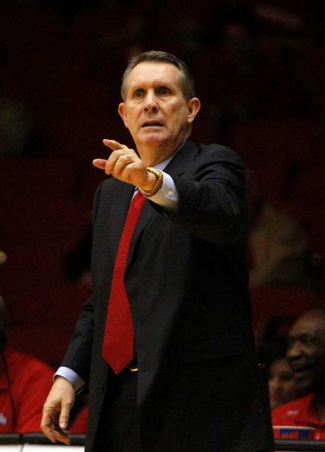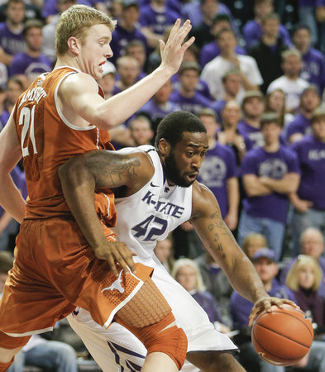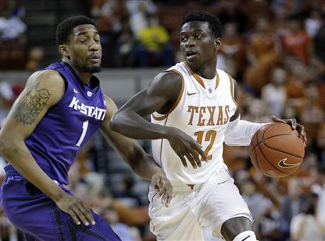| Texas Longhorns 76, Mercer Bears 73
A tumultuous offseason came to a close for the Texas basketball team on Friday night, as the Longhorns finally tipped off their 2013-14 campaign with a game against the Mercer Bears. With huge questions surrounding the young, rebooted lineup and fan expectations at their lowest point in more than a decade, the Horns put together an exciting — albeit inconsistent — performance to start the season with a 76-73 win.
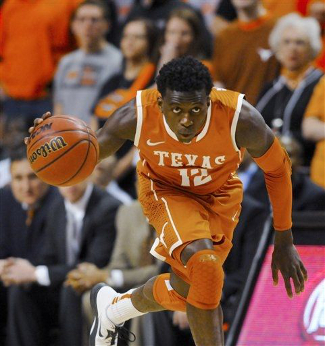
Myck Kabongo bolted from the 40 Acres this summer
(Photo credit: Brody Schmidt/Associated Press)
The offseason turmoil was well-documented, with five different Longhorns leaving the program after the 2012-13 season ended with a loss to Houston in the CBI. Forward Jaylen Bond actually announced his departure just before that game, and ultimately landed at Temple. Shooters Sheldon McClellan and Julien Lewis both hit the bricks shortly after, heading to Miami and Fresno State, respectively. Point guard Myck Kabongo decided to test the NBA waters, and was not selected in June’s NBA Draft. Kabongo is currently on the roster of the Austin Toros of the NBA’s D-League.
While only Bond’s decision wasn’t seen coming a mile away, even that one was understandable considering the pecking order in Texas’ frontcourt. But the biggest offseason blow did come as a surprise, as the versatile forward Ioannis Papapetrou decided in August to go pro in his native country of Greece. The Texas roster was decimated, forcing Coach Rick Barnes to hold an open tryout just to pick a few walk-ons and get enough bodies for practice.
The final roadblock in the soap-opera offseason came when sophomore point guard Javan Felix had sports hernia surgery at the start of October. The Texas program gave no recovery timetable, leading to debates amidst the dwindling fanbase over who would run the point for the Horns as the season tipped off.
The roster upheaval was the biggest storyline of the last seven months, but another had emerged during the disastrous 2012-13 season and it carried over into the summer. Long a topic in the echo chamber of internet message boards, the fate of Coach Barnes was being discussed by mainstream media. With the early struggles of the football team and rumors swirling about Athletic Director DeLoss Dodds, many fans and sportswriters were talking about the inevitable waves of change headed for Bellmont.
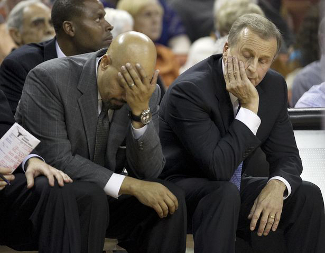
Rick Barnes is under the microscope this season
(Photo credit: Ralph Barrera/Austin American-Statesman)
The first of those changes came with last week’s announcement of Steve Patterson as the next Texas AD, and it set an interesting backdrop for Barnes and the Horns as the season tipped off. The consensus from both the media and fans is that the Longhorns are in for another rough season, and many believe it will be the last for Coach Barnes. Others suggest that with expectations set so low, Barnes should be able to meet or exceed them and buy himself more time.
While the big-picture questions will likely be shadowing the program all season long, the Longhorns were at least able to start to answer some of the questions about the team in Friday night’s win. The Longhorns pushed the tempo and showcased a shooting touch that was sorely lacking last season. It was apparent that although Texas may struggle to log wins this year, the team will at least make it entertaining for its fans.
The recap
The Longhorns came out firing, shooting 50% from the field and knocking down six triples to build a lead as large as 12 points late in the first half. The experienced Mercer squad refused to fold, and its leader Langston Hall quickly responded with seven points in a 30-second stretch. The teams traded buckets as the half wound down, and the Longhorns took just a three-point edge to the locker room.
Mercer turned things around in the second half, finally finding its range from behind the arc. After shooting just 3-for-16 on threes in the first twenty minutes, the Bears drilled six of their next nine attempts and stormed to a nine-point lead with 9:44 to play. Staring a season-opening loss in the face, the Longhorns put a renewed focus on their interior scoring and turned up the defensive pressure. Fueled by Cameron Ridley’s second-half surge, Texas went on an 18-2 run in less than seven minutes.
Mercer continued to claw at the narrow margin in the final minutes, and the Bears found themselves with an opportunity to tie the game with five seconds left. Coach Barnes elected not to foul with his team up three, and the Bears found Jakob Gollon on the left wing for a potential game-tying trey. Connor Lammert stood tall and barely left his feet, blocking the final shot to secure an opening-night victory.
What looked good
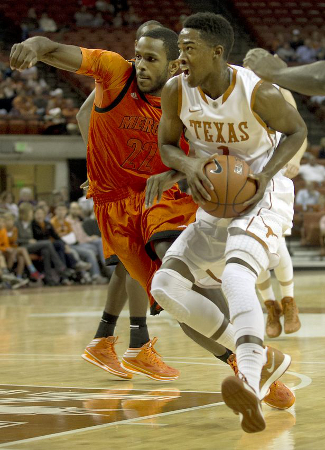
Isaiah Taylor had a solid collegiate debut
(Photo credit: Ralph Barrera/Austin American-Statesman)
The brightest spot for Texas and its fans was the excellent debut from freshman Isaiah Taylor. The youngster ran the point, shifting Felix off the ball to an undersized shooting-guard role. Taylor made quick, aggressive moves with the ball, and was able to shift gears in an instant to keep the defense off-balance. His smooth handles made it easy to weave through traffic, and he took full advantage of the new emphasis on defensive contact to earn fourteen trips to the line. He also showed an ability to pull up and hit the floater in traffic, something the tiny guard may have to rely on against bigger, stronger opponents. Taylor finished with 17 points in 29 minutes of action.
While Taylor didn’t attempt a three-pointer in the game, the rest of the Longhorns found a ton of success from beyond the arc. Texas made six of their eight three-point attempts in the first half and finished the game with a 46.7% success rate. Last season, the Longhorns made just 29.7% of their threes on the year, and cracked the 40% mark in just five of their 34 games.
Three of the long-range makes came from Texas big men, with Jonathan Holmes knocking down a pair and Lammert adding the third. Holmes showed the ability to hit three-pointers last year when he took them in rhythm, and that trend continued in the season opener. His first came as a trailer in transition, while his second was a wide open look late in the game. Lammert added his on a pick-and-pop play. If the Texas forwards can consistently make their long-range looks, it adds an extra dimension to the Longhorn offense that will spread the floor and open up driving lanes.
Freshman Damarcus Croaker also added two threes on back-to-back possessions, with a defender providing token pressure on both. He threw a pass out of bounds moments later and sat on the bench for the rest of the game, but it’s reassuring to know that the new guards will at least add some long-range pop. Although one game is certainly not a sample size worthy of any true conclusions, there’s reason to believe that Texas fans might not have to struggle through the painful scoreless stretches of last season.
The Longhorn offense also came from the entire stat sheet, as all ten players who saw the floor scored at least two points. Big man Prince Ibeh made two out of three free throws to log his points, which is certainly noteworthy after he made just 37.5% of his free throws last year.
The Texas offense also featured good ball movement, especially right out of the gate. The three-guard lineup whipped the ball around the perimeter as they looked for post entry opportunities. Although the Mercer defense is experienced and generally well-disciplined, when the Bears were caught out of position, the Texas guards were quick to put the ball on the floor and attacked the defense off the bounce. While last year’s team often passed the ball around the arc with little direction or sense of purpose, there was a clear game plan for this one and the team stuck to it.
On the defensive end, there was a ton of energy. The Longhorns used a lot of zone looks, including a 1-3-1 and what even looked like a 1-2-2. They threw out some full-court pressure to force a few first-half mistakes and looked really strong in man-to-man as they mounted their comeback late in the game.
What needed work
On the flip side, that defensive energy didn’t always equal results in the first half. The Longhorns seemed overly amped up, repeatedly biting on head fakes. Texas trapped quite a bit out of their zones in the first half, but players who were supposed to be rotating were often late or lost their assignments. On one particularly poor defensive set, Holmes drifted towards a man flaring to the arc as the Longhorns trapped past the opposite elbow, and he let a Mercer player cut right behind him to the rim for an easy hoop.
Ridley also seemed to struggle in the zone, as his size and conditioning made it tough for him to match the energy and effort of his teammates for long stretches. Mercer was very disciplined when it came to making quick, crisp passes, and his lapses allowed for open midrange jumpers and cuts to the paint. However, when the Longhorns switched to a man-to-man at the end of the first half and again in the second, Ridley actually looked phenomenal. He cleaned up shots from the help-side and also stood his ground to block shots from the Mercer bigs near the rim. Ridley finished the night with five blocks and 11 boards in 27 minutes of action.
While Ridley and Lammert provided a spark down the stretch, it took a while for the Texas interior game to get going. The bigs were working hard to establish post position in the first half, but they simply weren’t clicking with the guards. On some possessions, the bigs couldn’t get position for a good entry pass, while on others they would finally get their spot but the guards couldn’t find them. On the few occasions in the first half where the ball made it down low, the Texas bigs were usually out of position or they struggled to make a good move.
Fortunately, things changed down the stretch, as the guards and bigs worked together to get good angles down low and seal off the defenders. Ridley and Lammert logged some easy layups as a result, while the latter also cleaned up the glass with some key tips from the weak side late in the game.
A recurring problem last season was Felix getting himself into tough situations, and unfortunately that was again an issue against Mercer. Javan had three turnovers on the evening, but also repeatedly had shots blocked when he drove against a set interior defense. He left his feet without a plan on a few occasions early in the game, leading to desperation passes into the teeth of the D. Felix did log nine assists on the game, but his 4-of-14 line is worthy of concern. It will take time for the point guard to settle into his new combo-guard role, so hopefully the decision-making and shot selection improve over time.
The turnover bug was not just an issue for Felix, but for the entire Longhorn roster. Although the turnover rate of 17.9% was an improvement on last year’s 21.4% mark, that isn’t saying much. Texas was in the bottom third of Divison I hoops last season, so it would be tough to match that level of carelessness this season.
The Horns had six turnovers in the first 8:16 of the game, but managed to tighten things up the rest of the way. It’s worth noting, however, that many of the miscues were of the self-inflicted variety. With a young team and a lot of new faces, it’s natural that teammates sometimes won’t be on the same page, but for a Texas team that is going to have to battle for every win, the unforced errors will have to be reigned in.
Up next: vs. South Alabama (1-0); Tuesday, 7 P.M. CT
| 







